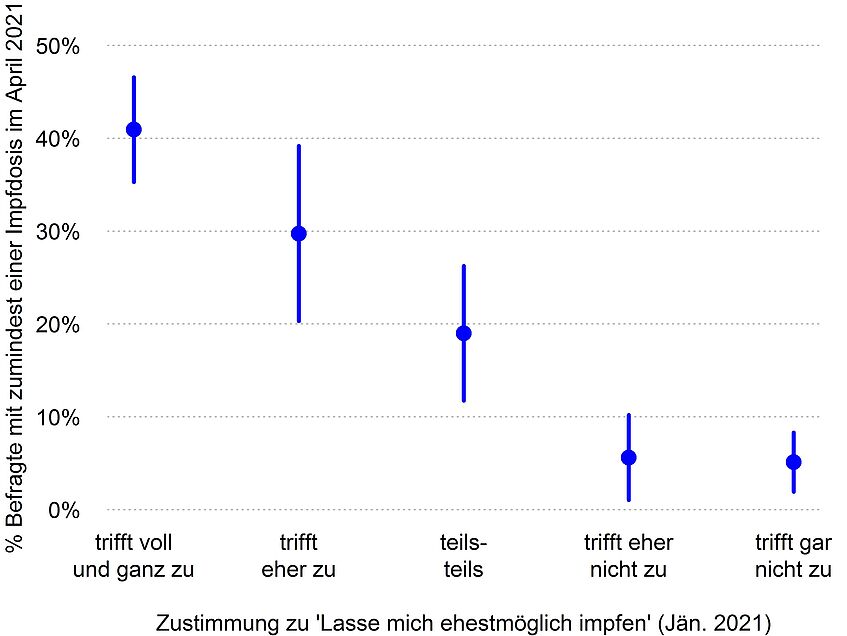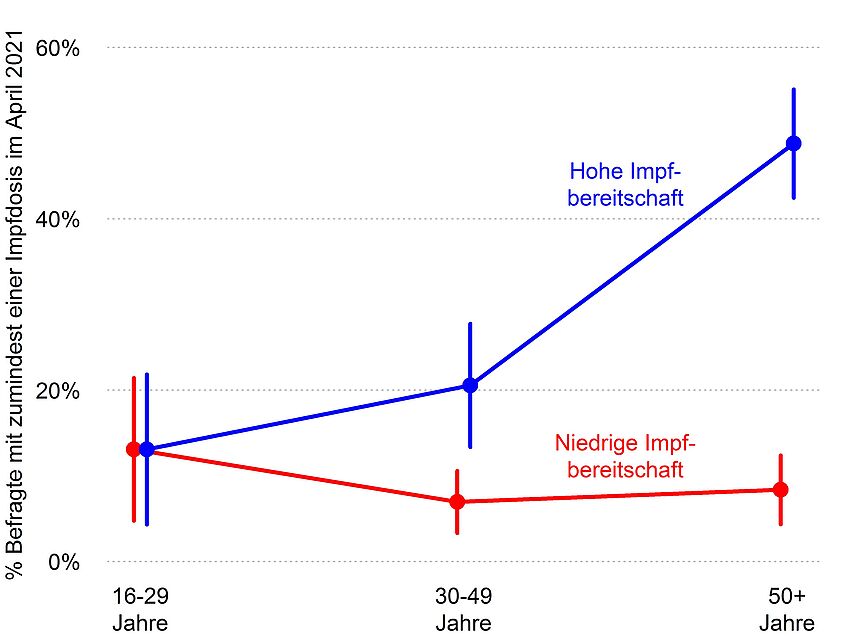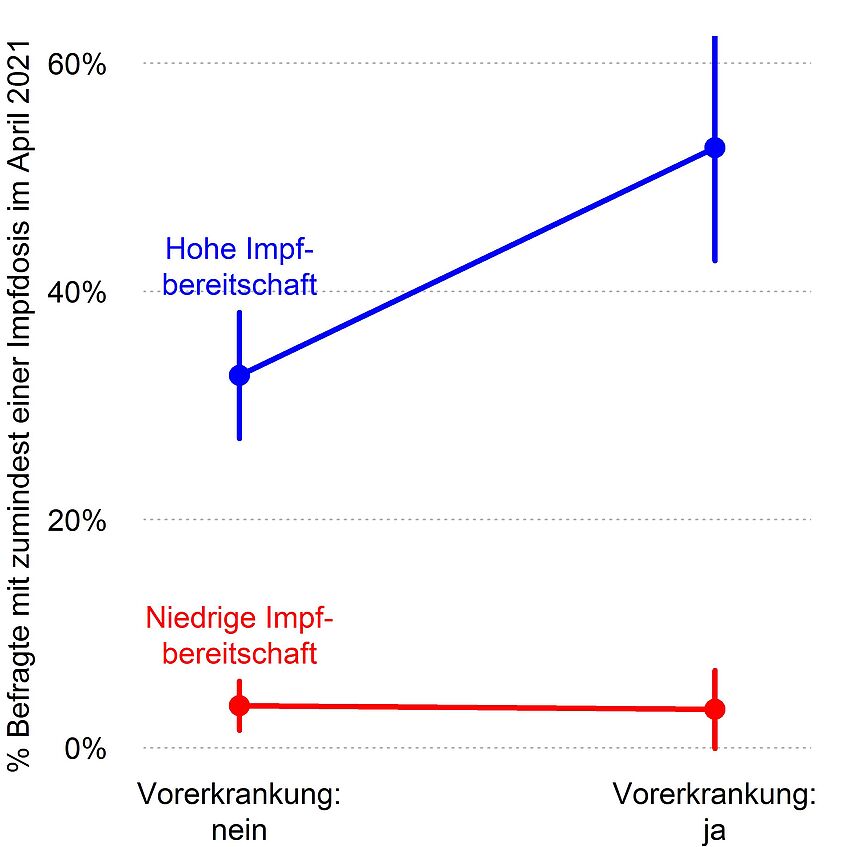31.05.2021 - PDF
Vaccination readiness: Do deeds follow words?
- Announced willingness to be vaccinated has a strong impact on the actual uptake of coronavirus vaccination.
- Even objective risk factors such as age and pre-existing conditions do not lead to higher vaccination rates among individuals with low vaccination readiness.
- Therefore, the current vaccination campaign, which focuses on the supply side, does not adequately reach persons with low vaccination readiness.
- An effective vaccination campaign would need to be expanded to include long-term strategies that also stimulate demand among hard-to-reach individuals.
Von Laurenz Ennser-Jedenastik, Katharina T. Paul und Jakob-Moritz Eberl
The opinions of the Austrian population on coronavirus vaccination differ. Although the general willingness to be vaccinated has recently increased again, a not insignificant part of the population remains skeptical to vaccination. However, it is important to keep in mind that it is not the attitude toward vaccination that is ultimately decisive for the development of the pandemic in Austria, but its actual uptake. On the one hand, some people may show a willingness to vaccination when asked in a survey, but then tend to be reluctant in practice. On the other hand, information campaigns, social pressure, and the role model effect in the social environment may lead some skeptics to get vaccinated if they are given the opportunity despite any reservations they may still have. Only if vaccination skepticism leads to people actually not getting vaccinated will it become a problem in pandemic control.
Within Austrian Corona Panel Project, we not only determined the attitudes of the Austrian population towards coronavirus vaccination, we also asked whether anyone had already received the first or even second partial vaccination. In this blog, we would now like to take a look at how close attitudes and practice are when it comes to corona vaccination. That is, we want to know how willingness to vaccinate and actual vaccination are related.
Vaccination readiness: words are followed by actions
We compare the expressed respondents’ willingness to vaccinate in the January wave of the Austrian Corona Panel Project with the vaccination status reported by the same respondents in April. A high correlation between vaccination skepticism and vaccination readiness would indicate that words are followed by actions.
In April, 22% of our respondents reported receiving at least one partial vaccination. Figure 1 now shows that actual vaccination uptake is strongly correlated with previously expressed vaccination readiness. Among respondents who reported high vaccination readiness in January ("strongly agree"/"trifft voll und ganz zu"), the vaccination rate in April was a whopping 41%. This is 19 percentage points higher than the average. Of those who were still rather or very skeptical in January ("strongly disagree"/"trifft eher nicht zu" or "trifft gar nicht"), just six and five percent respectively said in April that they had received at least one vaccination. The willingness or skepticism to get vaccinated expressed in surveys is therefore also reflected in actual behavior.
This correlation between willingness to be vaccinated and uptake of vaccination maintains a similar strength when we take into account the age of the respondents.
Skepticism beats objective risk factors
Vaccination skepticism would be particularly serious among vulnerable groups (especially the elderly and at-risk groups) if it discouraged them from seeking Corona vaccination. Our data show that this is exactly the case. In principle, at the time of the survey (April 2021), older people and those with relevant pre-existing conditions, in particular, should be overrepresented among those already vaccinated, based on the prioritization undertaken in all states. This is also the case - but only in the group of those willing to be vaccinated.
Figure 2 shows that among respondents with high vaccination readiness (answer "strongly agree"/"stimme voll und ganz zu" or "somewhat agree"/"stimme eher zu" in January 2021), the vaccination rate increases sharply with age. For example, 13% of 16- to 29-year-olds who are willing to be vaccinated are vaccinated, and the rate rises to 49% among persons 50 and older who are willing to be vaccinated. This is what would be expected according to the vaccination schedule. For the vaccine-skeptical group ("rather does not apply" or "does not apply at all"), there is practically no age gradient in the vaccination rate. Vaccination-skeptical 16- to 29-year-olds show a vaccination rate of ten percent in the survey, and among vaccination-skeptical respondents aged 50 and over, the rate is as low as five percent. In other words, even the objectively greatly increased risk of danger for older people does not overcome vaccination skepticism.
Similar results apply to the factor of pre-existing conditions/"Vorerkrankung: ja" (Figure 3). For this, we asked participants in our survey whether they suffered from one or more of the following pre-existing conditions: Cardiovascular disease, diabetes, hepatitis B, chronic obstructive pulmonary disease, chronic renal failure, or cancer. Among individuals with high vaccination readiness, those with pre-existing conditions have a significantly higher vaccination rate (53% vs. 33%). Among persons with low vaccination readiness, even the pre-existing conditions do not increase the vaccination rate (stable at three to four percent).
Conclusion
In general, our data show that queried vaccination readiness is very much related to subsequent vaccination decisions. However, our study also suggests that objective risks (e.g., age and aggravated disease progression) are not sufficient motivators to take up the vaccination offer. This is because those who were already critical of or even opposed to coronavirus vaccination at the beginning of the vaccination campaign have not yet taken advantage of existing offers. Thus, the current systematic offer alone does not trigger additional demand among those with low vaccination readiness.
From a policy perspective, this means that prioritization according to epidemiological criteria cannot stand alone and must be accompanied by effective communication measures and long-term strategies that not only create offers but also stimulate demand.
Laurenz Ennser-Jedenastik ist Assistenzprofessor am Institut für Staatswissenschaft und forscht und lehrt dort zu Sozialpolitik, politischen Eliten, Parteien und österreichischer Politik.
Katharina T. Paul ist seit 2013 Senior Research Fellow (Post-Doc) und Lektorin am Institut für Politikwissenschaft und seit 2019 Mitglied der Forschungsgruppe Zeitgenössische Solidaritätsstudien (CeSCoS). In ihrem FWF Elise Richter Projekt forscht sie zu vergleichender Gesundheitspolitik, insbesondere Impfpolitik.
Jakob-Moritz Eberl ist seit April 2017 Projektmitarbeiter (Post-Doc) am Institut für Publizistik- und Kommunikationswissenschaft und seit 2013 Mitglied der österreichischen Nationalen Wahlstudie (AUTNES, Media Side). Er ist außerdem assoziierter Wissenschafter im Vienna Center for Electoral Research (VieCER) und beschäftigt sich unter anderem mit Fragen zu Medienwirkung, Medienvertrauen und Wahlverhalten.
Verwandte Beiträge
- Blog 87 - Die Erosion der Impfbereitschaft in der österreichischen Bevölkerung
- Blog 93 - Die Impfbereitschaft der österreichischen Bevölkerung im Dezember 2020
- Blog 104 - Impfbereitschaft in Österreich stabil – Doch nicht jeder Impfstoff gleich beliebt
- Corona-Dynamiken 30 - Die Impfbereitschaft in der österreichischen Bevölkerung im April 2021



